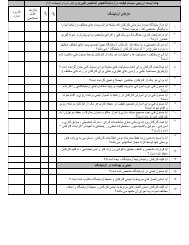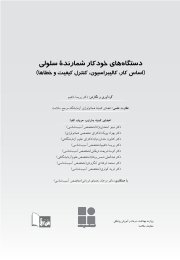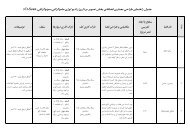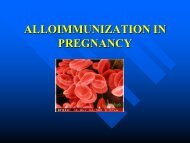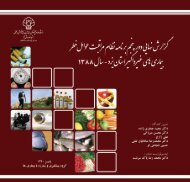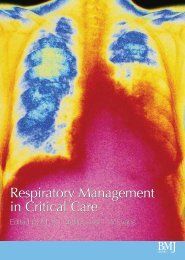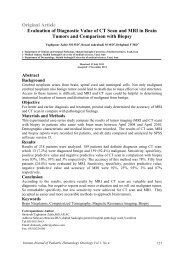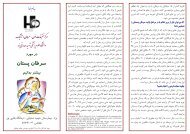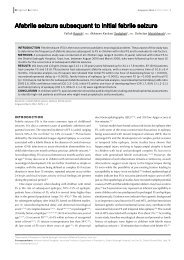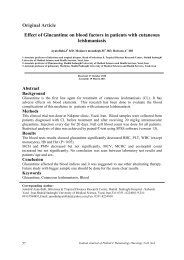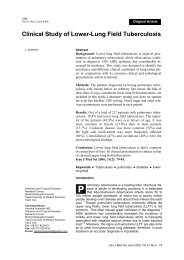Original Article Immunophenotyping of Leukemia in Children ...
Original Article Immunophenotyping of Leukemia in Children ...
Original Article Immunophenotyping of Leukemia in Children ...
- No tags were found...
You also want an ePaper? Increase the reach of your titles
YUMPU automatically turns print PDFs into web optimized ePapers that Google loves.
<strong>Immunophenotyp<strong>in</strong>g</strong> results are listed <strong>in</strong> Table 3. The most prevalent l<strong>in</strong>e <strong>in</strong> flow cytometrywas pre-B-cell, 29 patients (46.77%).Table 3: Frequency distribution <strong>of</strong> the most common markers accord<strong>in</strong>g to leukemia type and morphologicaltypeMarker <strong>Leukemia</strong> morphological type <strong>Leukemia</strong> type TotalCD19 number% <strong>in</strong> typeCD10 number% <strong>in</strong> typeHLA- numberDR % <strong>in</strong> typeCD34 number% <strong>in</strong> typeCD45 number% <strong>in</strong> typeL1 L2 M2 M3 M4 M7 UnknownAML22 24 1 1 0 0 088 92.3 50 33.3 0 0 020 23 0 0 0 0 080 88.5 0 0 0 0 017 19 2 2 1 0 268 73.1 100 66.7 50 0 1008 7 1 2 1 1 132 26.9 50 66.7 50 50 503 3 2 2 2 1 212 11.5 100 66.7 100 50 100ALL4690.24384.363670.581529.4611.8AML218.200763.64654.5981.848804371.74326.662133.871524.2The positive predictive value <strong>of</strong> CD19 for ALL is 95.8 % and negative p-value <strong>of</strong> it is 35.7%.Also positive p-value <strong>of</strong> CD10 for ALL is 100% and negative p-value <strong>of</strong> it is 42.1%. AboutHLA-DR, positive and negative p-value is 88% and 78.4 %, respectively.In this study, <strong>in</strong> addition to immunophenotyp<strong>in</strong>g, some factors such as hemoglob<strong>in</strong> value andcount <strong>of</strong> WBC were considered.Hemoglob<strong>in</strong> value was <strong>in</strong> 27 (43.5%) patients less than 7.5 mg/dl, <strong>in</strong> 25 (40.3%) between 7.5-10 mg/dl, and <strong>in</strong> 10 (16.1%) more than 10 mg/dl. In ALL patients, frequency was 20 (39.2%),25 (49%) and 6 (11.8%), respectively. In AML patients,<strong>in</strong> seven (63.6%) patients less than7.5 mg/dl and <strong>in</strong> 4 more than 10 mg/dl.Difference between AML and ALL was significant(P=0.007).The count <strong>of</strong> WBC <strong>in</strong> ALL was <strong>in</strong> 29 (58%) less than 2000, <strong>in</strong> 11 (22%) between 2000 to50000, and10 (20%) more than 50000. One patient has (2%) not report. The results <strong>in</strong> AMLpatients were 4 (36.4%), 3 (27.3%) and 4 (36.4%), respectively.Difference between AML andALL was not significant (P=0.379).The count <strong>of</strong> neutrophil was <strong>in</strong> 7 (14.3%) patients less than 500, <strong>in</strong> 8 (16.3%) between 500and 1000, <strong>in</strong> 7 (14.3%) between 1000 and 1500, <strong>in</strong> 27(55.1%) more than 1500, and 2 patients(3.92%) not reported. This count <strong>in</strong> AML patients, 2 (22.2%) was less than 500, 2 between1000 and 1500, 5 (55.6%) more than 1500, and 2 (18.18%) had not reported. Differencebetween AML and ALL was not significant (P=0.555).DiscussionIn the present discussion, HLA-DRwas 70.58 % <strong>in</strong> ALL patients and CD19 was the mostcommon marker <strong>in</strong> these patients. Philip Lanzkowsky has demonstrated that the mostcommon marker is HLA-DR, and CD19 is the second most important. The prevalence <strong>of</strong> L1is almost same as L2 <strong>in</strong> present study, but <strong>in</strong> Lanzkowsky book, L1 was 84% and L2 was 15%<strong>in</strong> ALL (11).Accord<strong>in</strong>g to other studies, it is possible to be a relationship between higher prevalence <strong>of</strong>HLA-DR and L1 and then connection between markers and morphology was considered hereand its results are presented as follow<strong>in</strong>g.In our <strong>in</strong>vestigation the prevalence <strong>of</strong> markers <strong>in</strong> L1, which was found <strong>in</strong> 25 patients and<strong>in</strong>volved 49% <strong>of</strong> all <strong>of</strong> ALL patients, was CD19, CD10 and I3 (HLA-DR) and also <strong>in</strong> L2,which <strong>in</strong>volved 51% rema<strong>in</strong><strong>in</strong>g <strong>of</strong> ALL patients, was as same as L1. Therefore the <strong>in</strong>cidence118 Iranian Journal <strong>of</strong> Pediatric Hematology Oncology Vol 1. No 4.




